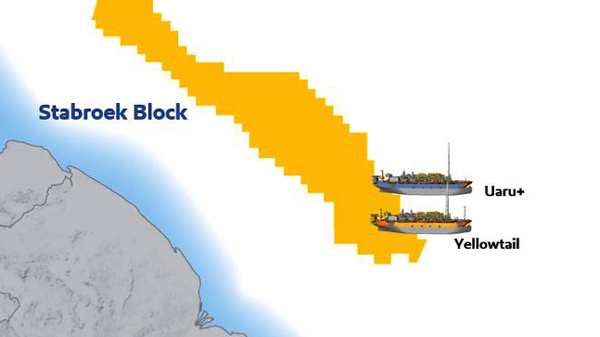
Kaieteur News
GEORGETOWN
EnergiesNet.co 04 13 2022
In January 2020, oil giant, ExxonMobil announced its 16th discovery, Uaru-1, in the Stabroek Block of Guyana’s Exclusive Economic Zone (EEZ).
In April last year, the company announced another oil find, this time its 19th dubbed Uaru-2 in the Stabroek Block. ExxonMobil said that the well is located approximately 6.8 miles (11 kilometres) south of the Uaru-1 well.
he two separate announcements or discoveries are, however, being pursued through one application process, as one project, under the guise of Uaru+ as was announced by ExxonMobil Guyana President, Alistair Routledge, as the final investment decision for its fourth project, the Yellowtail development, which was declared last week.
In fact, this newspaper was told by Exxon’s Public Relations Officer (PRO), Janelle Persaud, that the Uaru+ project is also seeking to develop other discoveries in the Stabroek Block that are within close proximity to the Uaru discoveries.
She pointed out that presently, the only identified discoveries for which approval is being sought is Uaru 1 and 2. Persaud was also keen to note that since the two discoveries are being pursued as one project, one Floating Production Storage and Offloading (FPSO) vessel would be required for the operation, along with the other supporting equipment.
Messages sent to the head of the Environmental Protection Agency (EPA), Mr. Kemraj Parsram, for details pertaining to the application went unacknowledged since Saturday.
Nevertheless, while making the announcement on April 4, Routledge said that the company’s application for the fifth project reflects Exxon’s commitment to “steadily and responsibly” develop the more than 10 billion oil equivalent barrels found in Guyana’s waters.
He pointed out, “These developments and our ongoing exploration success will enable the continued advancement of our Guyanese workforce and the companies that are supporting our activities, all while enabling enhanced economic growth for the country.”
Routledge also boasted of how the revenue from oil has been beneficial for the country’s growth. “The direct revenues the government is receiving have surpassed US$600 million and growing quickly as a result of high oil prices and the recent startup of Liza Phase Two Project. Revenues from the first two years of operation have been incorporated into the 2022 government’s Budget to support key national projects,” the ExxonMobil Guyana President related.
Additionally, he highlighted the benefits of the company’s operations to the local workforce, as more than 3,600 Guyanese are presently involved in the development of the country’s resource. In fact, this figure represents an increase of more than 50 percent since 2019, according to him.
Local companies have also been reaping the benefits of Exxon’s operations, Routledge said, as over 880 local suppliers have been supporting the company since 2015, which account for more than US$6 million of its expenses.
It was only on April 1 that the EPA announced it approved the Environmental Authorisation for Exxon’s fourth project, the Yellowtail development, pegged at US$10B. The Environmental Permit was granted for a period of five years to Exxon’s subsidiary and operator of the Stabroek Block, Esso Exploration and Production Guyana Limited (EEPGL) to undertake the requisite construction and operation of production facilities.
Oil production is also presently ongoing at the Liza One and Two projects, while the third project, Payara is slated for startup in 2024. Production at Yellowtail is set to commence in 2025.
About Uaru+
The Uaru-1 discovery was announced in January 2020. Uaru is ExxonMobil’s 16th oil discovery in the Stabroek Block. The well was drilled in a new reservoir, encountering some 94 feet (29 metres) of high-quality oil-bearing sandstone reservoir and was drilled in 6,342 feet (1,933 metres) of water.
Meanwhile, Uaru-2 was announced in April 2021. ExxonMobil said that drilling at Uaru-2 encountered approximately 120 feet (36.7 meters) of high quality oil bearing reservoirs, including newly identified intervals below the original Uaru-1 discovery. The well was drilled in 5,659 feet (1,725 metres) of water and is located approximately 6.8 miles (11 kilometres) south of the Uaru-1 well.
kaieteurnewsonline.com 04 12 2022







